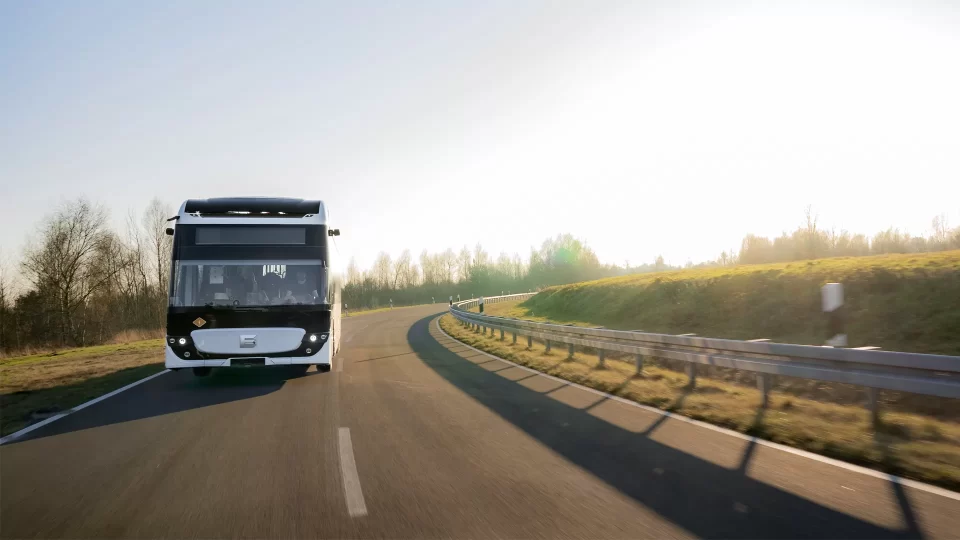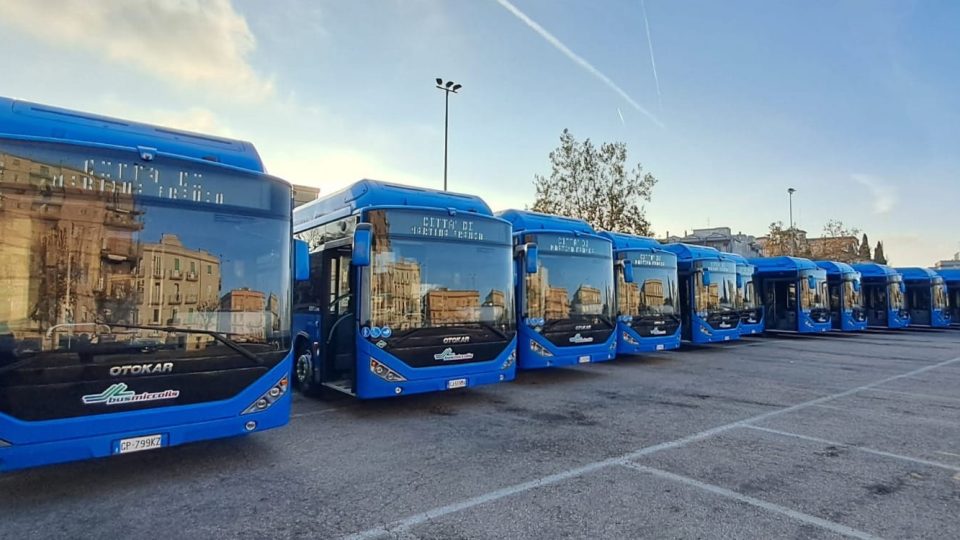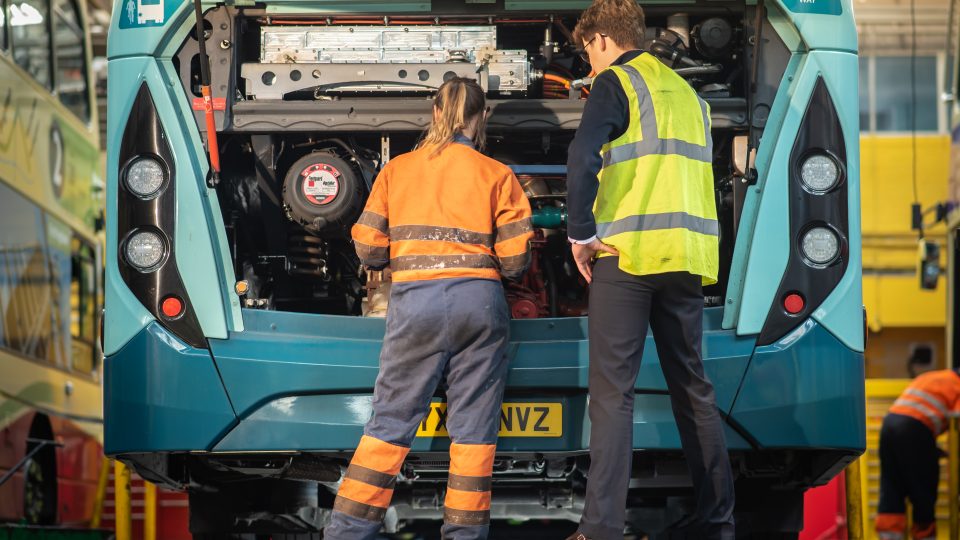Iveco Bus Crossway LE vs Setra MultiClass S 500 LE: the Low Entry challenge is here!
A comparison between what are arguably the two most representative Low Entry bus models, both of which have recently undergone a range update: the Setra MultiClass, which contributed to the boom in this segment with its previous 400 series and now offers the revamped 500 series; and the Iveco Crossway, which is the undisputed European leader and offers versions with every type of fuel - battery-electric included.
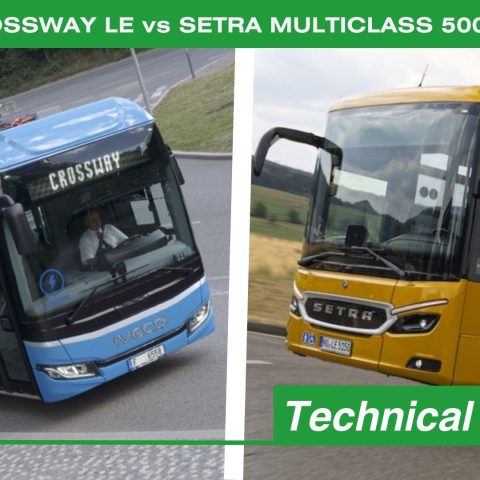
Below, an article published on February 2024 issue of Sustainable Bus magazine.
A comparison between what are arguably the two most representative Low Entry bus models, both of which have recently undergone a range update: the Setra MultiClass, which contributed to the boom in this segment with its previous 400 series and now offers the revamped 500 series; and the Iveco Crossway, which is the undisputed European leader and offers versions with every type of fuel – battery-electric included.
The Low Entry is a type of bus that is destined to become more and more popular, at least in the Class II segment. The reasons for such popularity are essentially two: one is related to accessibility, the other to the ecological transition. The (partially) lowered floor enables fast passenger handling and only requires a practical and quick manual ramp for wheelchair access.
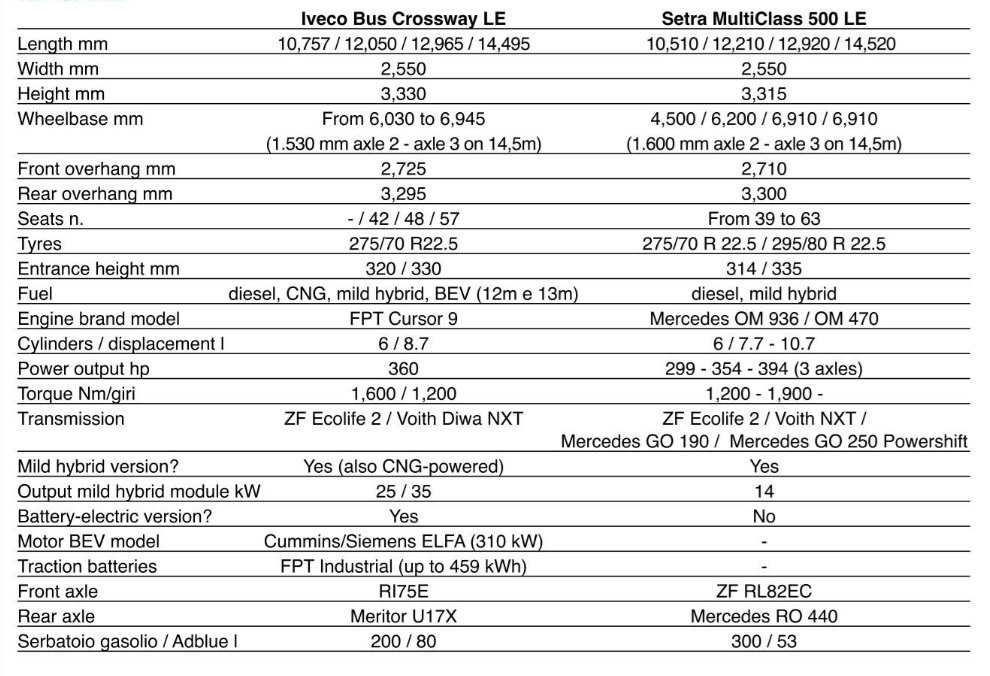
Moreover, it proves more flexible to accommodate alternative drive technologies, which are almost always positioned on the roof, perhaps taking advantage of a specially modified load-bearing structure in order to keep the overall height within acceptable values. On the other hand, Low Entry buses must necessarily give up some seats in addition to the luggage compartment, while generally maintaining the overall passenger capacity.
In addition, they cost more than the normal floor counterparts, positioning themselves almost behind the fully lowered buses.
So? The prevalence of the ecological factor will certainly make this segment grow, in an inevitable and definitive transformation of the ‘classic’ suburban service into a metro-suburban service. But at that point, the question will be whether it still makes sense to demand a Class II on certain lines, where the construction differences are probably not justified by the final use of the vehicle.
— Iveco Crossway LE —
Europe’s most popular Low Entry has further strengthened its market position with natural gas (also accompanied by mild hybrid module) and even electric variants, thus meeting the growing demand for alternative fuels for extra-urban services.
The modular structure includes a body with side panels in plastic material, as well as doors made entirely of aluminium. The windows are of two heights, but, unlike the Setra, they are joined by a black body finish. The rear door is two-leaf as standard, while the choice remains for the front door, single or double. In the case of the natural gas and electric versions, the structure and bodywork of the front are suitably modified, so that the cylinders and batteries respectively are recessed on the roof, without altering the overall dimensions in height. A truly wise choice.
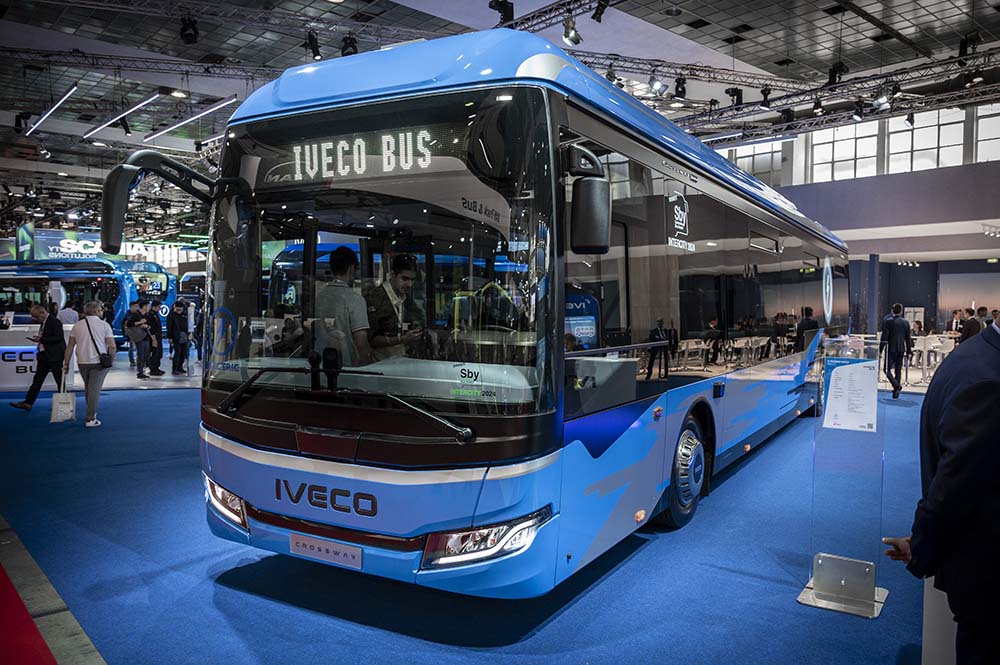
Successfully facelifted
The interior is made with the utmost rationality through the use of smooth, easily cleaned plastic panelling and upholstery. Furthermore, there are various possibilities for customisation, both on the passenger seats (as standard, there is the Lineo model, made in-house, with fixed or reclining backrest and armrest; other brands and models are also available), as well as for the interior walls (in laminate or carpeted), and for the spacious overhead luggage rack (equipped with individual service sets on request). The low-floor section is either entirely flat or, at the side of the aisle, with two fairly comfortable bases.
In the Class II layout, in order to achieve maximum capacity for seated passengers, four two-seaters are facing forward, two of which are fixed on the highest part of the front wheel arch. The interior layout allows up to 42 seats to be placed on the 12-meter version and 48 on the 13-meter model, in addition to 2 possible folding seats, to which at least twenty standing places can be added, depending on the number of batteries fitted. The air conditioning, in the diesel and natural gas variants, is entrusted to a 32 kW Thermoking series Athenia S805 system in cooling mode and integrates, for the heating function, unit heaters or wall-mounted convectors. Back to the electric version, there is currently a Thermoking E96I integrated rooftop unit, which from 2025 will be joined by a Konvekta UL700 CO2 heat pump system that aims to optimise performance and efficiency. Wall heating by circulating water within convectors is managed by a Valeo auxiliary heater that can be diesel-powered (or HVO), electric or mixed (dual).
At the driver’s seat
The driver’s seat has recently been redesigned and optimised in terms of space, with a new dashboard featuring additional and more rational controls. The central dashboard integrates the traditional analogue gauges and a 7-inch digital colour display that shows the main vehicle status information as well as signalling any malfunctions, allowing good basic onboard diagnostics. The driver’s seat complies with VDV and EBSF (European Bus System of the Future) standards and can be separated from the passenger compartment with full-height locks and a flap for on-board ticket sales. Options for the driver include the camera mirror system, consisting of two views per side plus an additional camera for approaching the right front corner.
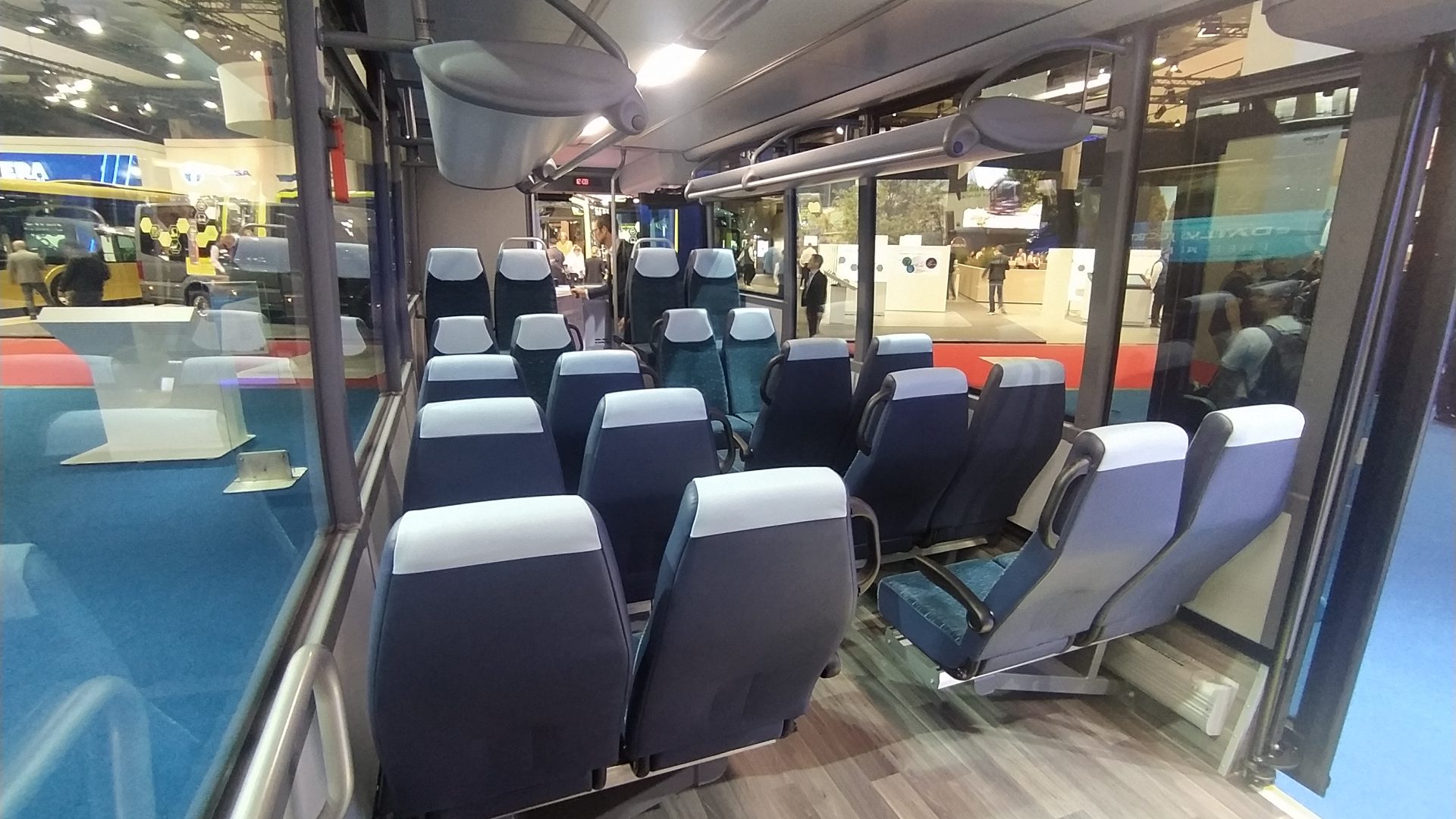
Any drivetrain you may want
The Crossway LE is offered with diesel or natural gas (both with the 360-horsepower Cursor 9) engines, as well as (since a few time) electric driveline. In case of internal combustion engine, the transmission is available as a six-speed ZF manual gearbox (for the 12-meter model only), six-speed ZF Ecolife 6AP1700 automatic or seven-speed Voith NXT automatic (four plus overdrive), to which the mild hybrid module can be coupled.
On the other hand, as mentioned, the all-electric version was recently launched. It uses the already proven technology of the urban E-Way. Available only in 12- and 13-meter lengths, the Crossway Elec uses a central motor, thus retaining the drive shaft and rear axle of the engine-powered versions. The motor will be soon the Siemens (now Cummins) ELFA 3, with 185 kW of maximum continuous power and 310 peak power, as well as a maximum torque of 3,000 Nm. The batteries are high energy density modules based on NMC chemistry, and they are partially assembled in Iveco’s European factories (the individual modules will also be made in-house in Turin soon by FPT) and with an in-house developed BMS.
Battery modules are internally-developed
Each module has a capacity of 69 kWh and a minimum of five to a maximum of seven modules can be mounted. They are distributed between the former engine compartment (two) and the front of the roof (three to five). Thanks to a 95 per cent ‘depth of discharge’, the total usable capacity is an impressive 459 kWh, with an expected lifetime of up to 15 years. Charging takes place via CCS2 combo sockets, which can be installed in five different positions, or via direct or reverse pantograph, in which case the power delivered by the infrastructure can reach 450 kW. We’re talking about a vehicle, therefore, that lends itself to both depot and Opportunity in-line charging.
For all variants, the front axle is the Iveco RL75E with independent wheels, while the rear axle is a hypoid type with single reduction. In the three-axle configuration, the third axle features electronic control, which is active in forward and reverse at low to medium speeds. All axles also offer overload control, depending on the maximum technically permissible wheel load.
The wheels only allow for 275/70 R22.5” tyres, the same tyres as on urban vehicles but not those used on the Normal Floor Crossway, proving not always suitable for winding roads with frequent changes in gradient. The load index limits the maximum homologation mass to 19,100 kg, not allowing full use of the 19.5 tonne limit. And 400 kg means at least five fewer passengers.
— Setra MultiClass S 500 LE —
Presented a few months ago and seen at Busworld in October, the new MultiClass 500 series is not the result of a simple restyling. On the contrary, it is a specific design that optimises weight and integrates all the safety devices that will become mandatory in the coming months. Design goes against the grain, avoiding (more or less clumsy) attempts to harmonise two different window heights, even highlighting the separation between the lowered front and the raised rear, inserting a body-coloured element behind the rear door. The front end benefits from the aesthetic changes recently applied to the turistic family, with new all-LED front light clusters with an overlying ‘bar’ integrating clearance lights, daytime running lights and direction indicators. Further down, the fog lights are set into a black panel, which houses the sensors for Preventive Brake Assist 2, a driver assistance system capable of activating partial braking in the event of obstacles, while still taking standing passengers into account.
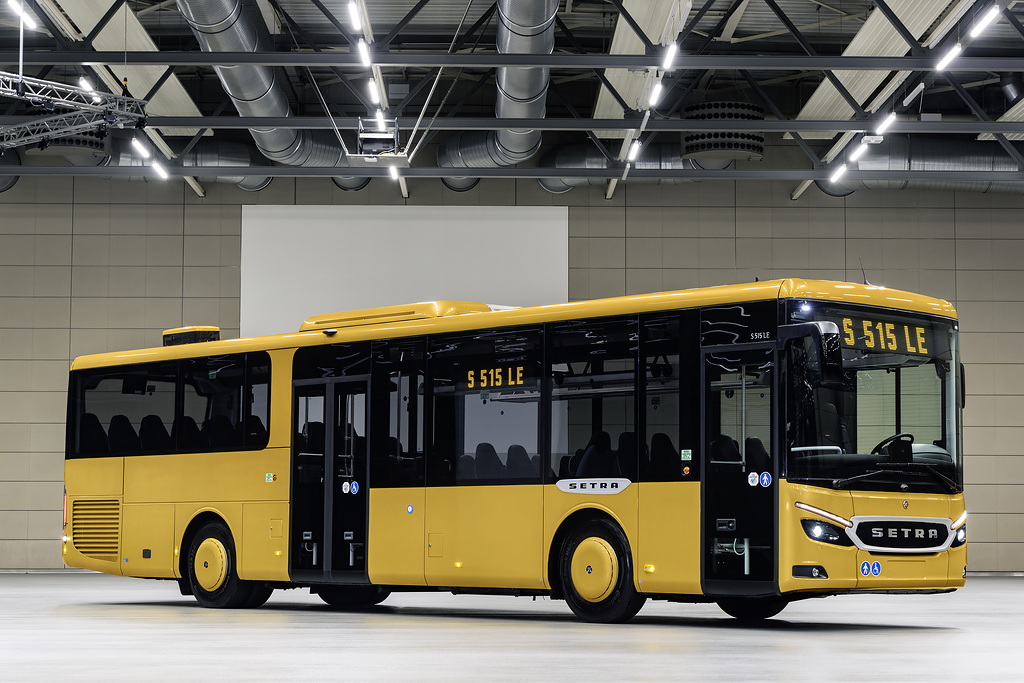
A modular redesign made it possible to obtain four lengths, as for the other models, all with a partially lowered floor. The modular structure envisages, for all variants, the same overhangs (2,710 mm at the front and 3,300 mm at the rear), just as the central door position remains unchanged, always 1,540 mm in front of the drive axle.
Four sizes available
As anticipated, there are four sizes: 10.51 meters (S510 LE), 12.21 meters (S515 LE) and 12.92 meters (S516 LE) for the two-axle versions, in addition to 14.52 meters (S518 LE) for the three-axle version. The first vehicles in the intermediate lengths are already on delivery, while for the ‘normal’ and ‘extra-long’ models we have to wait a few more months.
The two access doors in the lowered section can be single (900 or 1,150 mm compartment) or double doors (1,380 mm compartment), with an optional third single door behind the rear axle, with three steps inside. Depending on the door type, there is a choice between an inward-rolling and an outward-rolling movement.
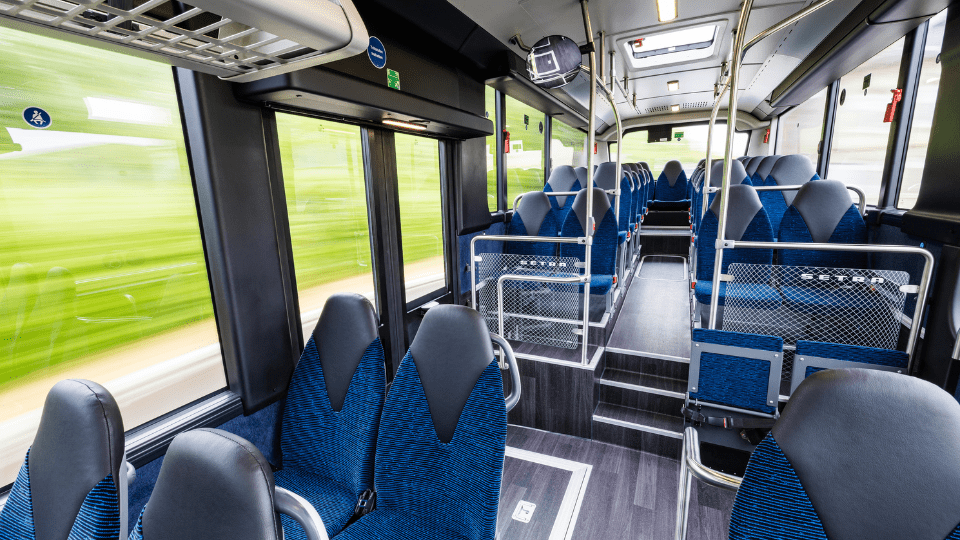
Seating capacities are interesting in configurations without wheelchairs’ area, from 39 to 63; in the case of a platform, however, there are four fewer seats (excluding any folding seats). Still speaking about seats, there are different types available on the MultiClass, depending on whether Class I or Class II homologation is requested. They range from the monocoque for urban use, to the classic fixed upholstered seat for short- and medium-haul scheduled services, to the semi-tourist seat equipped with all the accessories to cope with longer transfers in comfort. According to this principle, even the overhead luggage racks (available on request only in the lowered part) can include individual lights and air vents.
Air conditioning is provided by a roof unit with a cooling capacity of between 32 and 39 kW, supplemented by a driver’s front box with a separate evaporator, plus a set of unit heaters for the passenger compartment. There are even three types of dashboard in the driver’s seat: the Cockpit City (compliant with VDV regulations), the Cockpit Basic City (more suitable for scheduled service) and the Cockpit Basic (more similar to the ComfortClass touring range). Of course, each of these allows for further customisation in the number and position of individual controls.
How to improve driver’s life…
The rain sensor, the light sensor and the electronically controlled parking brake are standard equipment. The latter combines practicality of use with safety: to engage the brake, simply operate the brake lever or the ‘P’ button, while to release it, simply press the accelerator or press ‘P’ again, integrating the hill start assist function. Brake activation can also occur automatically when the driver unbuckles the seat belt while the vehicle is stationary.
Options include an advanced 360° view system, consisting of four cameras (two on the sides and two on the heads) and a 10-inch monitor mounted to the left of the windscreen and divided into two parts: one shows the four sides of the bus at the same time, while the other switches automatically according to the direction taken or when reverse gear is engaged (or according to the driver’s choice). The device is normally active at speeds below 30 km/h and can take images up to a distance of 5-6 meters from the vehicle, i.e. more than an entire lane.
Under the bonnet of the Setra MultiClass 500 LE
The powertrain is made up of familiar and reliable components: the two-axle vehicles are equipped with the popular 7.7-litre OM 936 inline six-cylinder engine, which is available in the two usual power ratings of 299 and 354 horsepower; the three-axle model, on the other hand, is fitted with the 10.7-litre OM 470 inline six-cylinder engine with 394 horsepower. Both can be powered by HVO and the 7-litre model, like the Intouro, can be complemented by the mild hybrid module. In this case, a 14 kW auxiliary electric motor is installed between the engine and gearbox, acting as a current generator when releasing and braking, as well as supporting the heat engine at start-up, thanks to two small 48 VDC supercapacitors mounted on the roof.
As many as four gearboxes are available, although not all of them can be matched to all models: the Mercedes GO 190 six-speed manually-controlled mechanical gearbox (for two-axle models only), the ZF Ecolife 2 six-speed automatic gearbox, the Voith NXT seven-speed automatic gearbox, or the Mercedes GO 250 PowerShift eight-speed automated mechanical gearbox. The GO 250 8 automated mechanical transmission is paired with the latest version of PPC (Predictive Powertrain Control), which is capable of adapting the gear shift programme to the driver’s driving style and, above all, to the topography of the road. The predictive function integrates a vehicle localisation system and a map archive for the whole of Europe, so that it acts not only when changing gears but also when approaching crossroads, road junctions and built-up areas; safety, driving comfort and fuel consumption all benefit from it.
The axles remain the independent-wheel ZF RL82EC at the front and the hypoid-type Mercedes RO 440 at the rear, with numerous possible gear ratios, ranging from i = 3.1 to i = 5.87, depending on the chosen transmission and the standard route type. The third axle of the 518 LE is independent-wheel drive and provides active steering control even in reverse. Depending on the type of service required, the wheels can be fitted with either 275/70 R 22.5 city tyres or 295/80 R 22.5 extra-urban tyres, which bring the sill height to 314 mm and 355 mm respectively, excluding kneeling.




